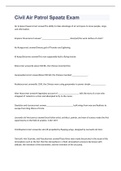Civil Air Patrol Spaatz Exam
Air & Space Powercorrect answerThe ability to take advantage of air and space to move people, cargo, and information.
Emperor Shuncorrect answer"_________________________ donn[ed] the work clothes of a bird."
Kei Kungcorrect answerChinese god of Thunder and Lightning:
Ki-Kung-Shicorrect answerThis man supposedly built a flying chariot.
Kitecorrect answerAt about 500 BC, the Chinese invented this:
Gunpowdercorrect answerAbout 900 AD, the Chinese invented ______________.
Rocketscorrect answerBy 1100, the Chinese were using gunpowder to power simple _____________.
Wan Hoocorrect answerA legendary account of ___________________ tells the story of a man who strapped 47 rockets to a chair and attempted to fly to the moon.
Daedulus and Icaruscorrect answer________________________ built wings from wax and feathers to escape from King Minos of Crete.
Leonardo da Vincicorrect answerGreat Italian artist, architect, painter, and man of science made the first experiments on the field of aviation. 1452-1519
Ornithoptercorrect answerAn aircraft propelled by flapping wings, designed by Leonardo da Vinci.
Torricelli, Von Guericke, and Pascalcorrect answerThese three men made discoveries in the study of the atmosphere such as the fact that the atmosphere is a fluid, atmospheric pressure decreases with altitude, the invention of the barometer, and the invention of the air pump. Francesco de Lanacorrect answera Jesuit priest who wrote a proposal for an aerial ship, which was, in theory, close to the right idea of hot air balloons. he also discussed the need for ballast, controlled ascent and descent, and military uses for balloons.
Laurenco de Gusmaocorrect answerA Jesuit priest credited with the invention of the hot air balloon in 1709.
1766correct answerHenry Cavendish discovered a gas, now called hydrogen, that he called "flammable air."
Joseph and Etienne Montgolfiercorrect answerTwo papermakers from Annonay, France who first achieved manned flight.
June 5, 1783correct answerFirst flight by the Montgolfier brothers' hot air balloon.
November 21, 1783correct answerThe Montgolfier brothers' second flight with a sheep, a rooster, and a duck inside the balloon.
Pilatre de Rozier and Marquis d'Arlandescorrect answerFirst men to fly in a lighter-than-air aircraft over Paris, France.
August 27, 1793correct answerJAC Charles used hydrogen to float a hot air balloon.
December 1, 1783correct answerFirst manned flight in a hydrogen balloon.
76correct answerBetween 1783 and 1790, _____ Flights were recorded in France alone.
1793correct answerFrance formed an air arm to their Army, beginning to use balloons for reconnaissance.
1797, Andre-Jacques Garnerincorrect answerThe first parachute jump from 3000 feet. January 7, 1785correct answerJean Pierre Blanchard and Dr. John Jeffries flew across the English Channel.
November 10, 1798correct answerJeanne-Genevieve Garnerin, wife of Andre-Jacques Garnerin, became one of the earliest women to fly in a balloon.
October 12, 1799correct answerJeanne-Genevieve Garnerin became the first woman to parachute from a balloon.
Madeleine Sophie Blanchardcorrect answerThe first woman to be killed in a ballooning accident in 1819.
January 9, 1793correct answerFirst balloon flight in the United States
Thaddeus S. C. Lowecorrect answerOrganized Balloon Signal Service of the Union Army.
Dirigiblecorrect answerlighter than air aircraft that can be steered and propelled.
Henri Giffardcorrect answer1852, he is credited for inventing the first successful dirigible.
The LaFrancecorrect answerThe first airship powered by electric motors, built by Charles Renard and AC Krebs in 1884.
Paul Haenleincorrect answerIn 1872, he built a dirigible with an internal-combustion engine.
Santos Dumontcorrect answerThe first man to build and fly gasoline-powered dirigibles.
Ferdinand von Zeppelincorrect answerJuly 1900, this man built and flew the world's first rigid dirigible, the LZ-1, with a steel/aluminum framework. The Deutschlandcorrect answerThe LZ-7, the world's first commerical airship on June 22, 1910.
Absolute Chargingcorrect answerOccurs when the whole aircraft is charged.
Accelerationcorrect answerWhen a body is subjected to the application of force over time.
Acecorrect answerA pilot who shot down five enemy aircraft.
Active Communications Satellitecorrect answerA satellite, such as the Courier 1B, that received signals from ground stations, amplified them and then rebroadcasted the signals to receiving stations on Earth
Advectioncorrect answerLateral heat transfer that is important in the global circulation of air.
Advection Fogcorrect answerFog formed when wind blows moist air over a cold surface and the surface cools the air to its dew-point temperature.
Aeronautcorrect answerBalloonist
Aeronauticscorrect answerThe science and art of flying through the atmosphere.
Aerospacecorrect answerA compound term used to describe the atmosphere and space as one medium.
Aileronscorrect answerSmall flaps on the wings of aircraft that help control the plane.
Airfoilcorrect answerParts of an airplane, such as wings, tail surfaces, and propellers, designed to cause a
dynamic reaction from the air through which it moves.
Airframe Rocket Systemcorrect answerServes to contain the other systems and to provide a streamlined shape




